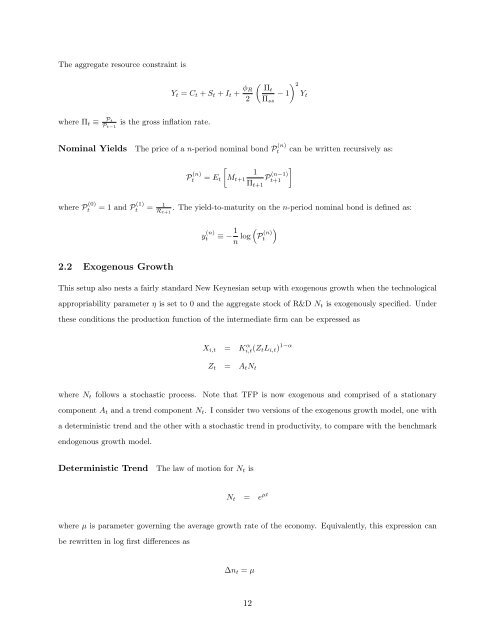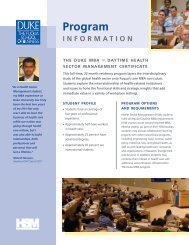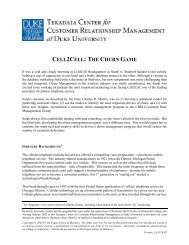Equilibrium Growth, Inflation, and Bond Yields - Duke University's ...
Equilibrium Growth, Inflation, and Bond Yields - Duke University's ...
Equilibrium Growth, Inflation, and Bond Yields - Duke University's ...
You also want an ePaper? Increase the reach of your titles
YUMPU automatically turns print PDFs into web optimized ePapers that Google loves.
The aggregate resource constraint is<br />
where Πt ≡ Pt<br />
Pt−1<br />
is the gross inflation rate.<br />
Yt = Ct + St + It + φR<br />
2<br />
� Πt<br />
Πss<br />
Nominal <strong>Yields</strong> The price of a n-period nominal bond P (n)<br />
t<br />
where P (0)<br />
t<br />
P (n)<br />
t<br />
= Et<br />
�<br />
1<br />
Mt+1<br />
Πt+1<br />
�2 − 1 Yt<br />
P (n−1)<br />
�<br />
t+1<br />
can be written recursively as:<br />
= 1 <strong>and</strong> P (1)<br />
t = 1 . The yield-to-maturity on the n-period nominal bond is defined as:<br />
Rt+1<br />
2.2 Exogenous <strong>Growth</strong><br />
y (n)<br />
t<br />
≡ − 1<br />
n log<br />
�<br />
This setup also nests a fairly st<strong>and</strong>ard New Keynesian setup with exogenous growth when the technological<br />
appropriability parameter η is set to 0 <strong>and</strong> the aggregate stock of R&D Nt is exogenously specified. Under<br />
P (n)<br />
t<br />
these conditions the production function of the intermediate firm can be expressed as<br />
�<br />
Xi,t = K α i,t(ZtLi,t) 1−α<br />
Zt = AtNt<br />
where Nt follows a stochastic process. Note that TFP is now exogenous <strong>and</strong> comprised of a stationary<br />
component At <strong>and</strong> a trend component Nt. I consider two versions of the exogenous growth model, one with<br />
a deterministic trend <strong>and</strong> the other with a stochastic trend in productivity, to compare with the benchmark<br />
endogenous growth model.<br />
Deterministic Trend The law of motion for Nt is<br />
Nt = e µt<br />
where µ is parameter governing the average growth rate of the economy. Equivalently, this expression can<br />
be rewritten in log first differences as<br />
∆nt = µ<br />
12
















